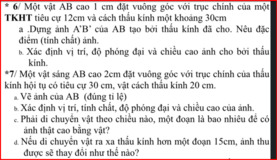mn giup e vs huhu
Hãy nhập câu hỏi của bạn vào đây, nếu là tài khoản VIP, bạn sẽ được ưu tiên trả lời.



a: \(\Leftrightarrow2x^2+6x-3x-9=0\)
=>(x+3)(2x-3)=0
=>x=3/2 hoặc x=-3
b: \(\Leftrightarrow6x\left(1-2x\right)=0\)
=>x=0 hoặc 1-2x=0
=>x=0 hoặc x=1/2
c: \(\Leftrightarrow8x^2=1\)
\(\Leftrightarrow x^2=\dfrac{2}{16}\)
hay \(x\in\left\{\dfrac{\sqrt{2}}{4};-\dfrac{\sqrt{2}}{4}\right\}\)
d: \(\Leftrightarrow x^4-9x^2+2x^2-18=0\)
\(\Leftrightarrow x^2-9=0\)
=>x=3 hoặc x=-3


Đường tròn (C) tâm \(I\left(-2;-2\right)\) bán kính \(R=5\)
Gọi đường thẳng d qua A có dạng: \(a\left(x-6\right)+b\left(y-17\right)=0\)
\(\Leftrightarrow ax+by-6a-17b=0\) (\(a^2+b^2\ne0\))
d là tiếp tuyến của (C) khi và chỉ khi \(d\left(I;d\right)=R\)
\(\Leftrightarrow\dfrac{\left|-2a-2b-6a-17b\right|}{\sqrt{a^2+b^2}}=5\)
\(\Leftrightarrow\left|8a+19b\right|=5\sqrt{a^2+b^2}\)
\(\Leftrightarrow\left(8a+9b\right)^2=25\left(a^2+b^2\right)\)
\(\Leftrightarrow\left(3a+4b\right)\left(13a+84b\right)=0\)
Chọn \(\left(a;b\right)=\left(4;-3\right);\left(84;-13\right)\)
Có 2 tiếp tuyến: \(\left[{}\begin{matrix}4\left(x-6\right)-3\left(y-17\right)=0\\84\left(x-6\right)-13\left(y-17\right)=0\end{matrix}\right.\) \(\Leftrightarrow...\)

37:
\(AB=\sqrt{\left(-2-1\right)^2+\left(4-2\right)^2}=\sqrt{13}\)
\(AC=\sqrt{\left(3-1\right)^2+\left(5-2\right)^2}=\sqrt{13}\)
\(BC=\sqrt{\left(3+2\right)^2+\left(5-4\right)^2}=\sqrt{26}\)
Vì AB^2+AC^2=BC^2 và AB=AC
nên ΔABC vuông cân tại A
=>S ABC=1/2*AB*AC=1/2*13=13/2
AH=13/2*2:căn 26=13/căn 26=1/2*căn 26



\(\left(5-2x\right)^2-16=0\)
\(\Leftrightarrow\left(5-2x\right)^2-4^2=0\)
\(\Rightarrow\left(5-2x-4\right)\left(5-2x+4\right)=0\)
\(\Rightarrow\orbr{\begin{cases}5-2x-4=0\\5-2x+4=0\end{cases}\Leftrightarrow\orbr{\begin{cases}-2x=4-5\\-2x=-4-5\end{cases}}\Leftrightarrow\orbr{\begin{cases}-2x=-1\\-2x=-9\end{cases}}}\)
\(\Rightarrow\orbr{\begin{cases}x=\frac{-1}{-2}=\frac{1}{2}\\x=\frac{-9}{-2}=\frac{9}{2}\end{cases}}\)
Vậy ................................






@ce giúp em với huhu
em đ@ng g@p
a) Trên cùng một nửa mặt phẳng bờ chứa tia Ox, ta có: \(\widehat{xOy}< \widehat{xOz}\left(60^0< 120^0\right)\)
nên tia Oy nằm giữa hai tia Ox và Oz
Suy ra: \(\widehat{xOy}+\widehat{yOz}=\widehat{xOz}\)
hay \(\widehat{yOz}=60^0\)
b) Ta có: tia Oy nằm giữa hai tia Ox và Oz(cmt)
mà \(\widehat{xOy}=\widehat{yOz}\left(=60^0\right)\)
nên Oy là tia phân giác của \(\widehat{xOz}\)